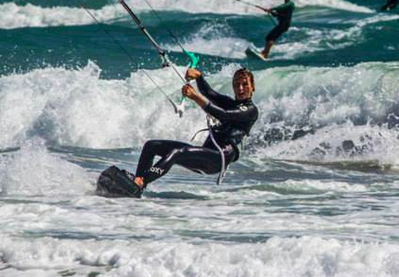
Once you are comfortable with your 1st rides what will happen naturally is that you start to transfer weight to your back foot. This is a natural process as people naturally want to engage the edge to give the board some more stability and it is in fact a much more comfortable riding position. If you are doing this and constantly stalling i.e. sinking back into the water it means you simply don’t have enough power in the kite at that moment as you engage the edge and so are braking the board too much and stalling. Play with this this is something that will come naturally rather than thinking about it. As you learn how much power is coming through the kite you will naturally start to transfer that power through your back heels into the board and that will start to turn the board up wind. There are however some things we can do to help the process along the way.
The 1st one is to really start looking where you are going. To start with you will be focused entirely on the kite but as soon as you feel you are able start to transfer your attention away from the kite and look upwind at the point you want to arrive at you’ll start to nice results. By looking at our destination what happens is you start to open up your shoulders and hips, much like on a snowboard.
Try it now, stand up now in front of the computer with your legs spread shoulder width apart shoulders facing forward. Now turn your head to the right and let your shoulders follow, notice where the weight is transferred to. If you’ve done it correctly and opened up your shoulders and hips you should notice that your left heel is now much more firmly planted on the ground and the weight has transferred from your right foot into this left heel. This is exactly the effect we are looking for by looking for. To transfer enough weight onto that backheel thereby engaging the edge and starting to drive ourselves up wind.
Shag don’t Shit
The other thing we need to start thinking about at this stage is pushing forward with the hips. This is where you may want to start considering riding in a waist harness. Seat harnesses are great while you are learning as they keep the spreader bar down and well away from your rib cage which is exactly what we want. As we start to ride seat harnesses tend to allow you to sit down in the seat harness to hold down the power of the kite adopting the classic “Shitting Position,” this is counter-productive at this point.
What we want is for you to push your hips forward and throw your head backwards off the back of the board in a shagging position. With a waist harness if you drop into this shitting position the harness will rise up under your armpits and be very uncomfortable (and more importantly look very uncool). For that reason I would recommend you to invest in a waist harness which will regulate your riding style, in that if you feel the waist high rise up round your armpits you know you’re doing it wrong. You should be pushing your hips forward to the point where the kite is almost pulling the waist harness down but certainly keeping in position around your waist.
The last thing we want to start thinking about at this point is dealing with waves. Waves are a bugger to the beginner. Especially the white water which is just a wall of water intent on sweeping your board out from under your ferret and dumping you unceremoniously back on the beach.
If at all possible aim for the green, unbroken wave as is much easier to navigate and its worth losing a bit of ground downwind to find a nice unbroken patch of water to cross at. This I appreciate is not always possible or easy.
If you have to cross the white water the best way to do it is as directly as possible. Angle your board to point directly into the wave if possible. As you approach the white water raise the kite and raise your foot and leg to accept the wave, let the white water pass under your board and as you exit the wave drop the kite hard and point the board slightly downwind again. The exit from the wave is as important as the entrance.
All that white foamy water behind the wave is heavily aerated. This means it doesn’t have much buoyancy and you often feel yourself being sucked down behind the wave. We need to get off this water as quickly as possible so drop the kite and get out there ASAP!
Another top tip when dealing with waves is to keep your knees bent as much as possible that way you can absorb as much of the power of the way through your legs as you can.